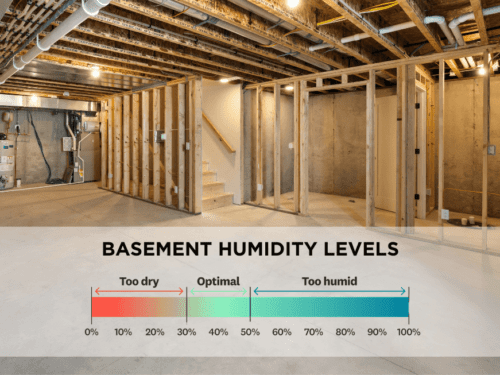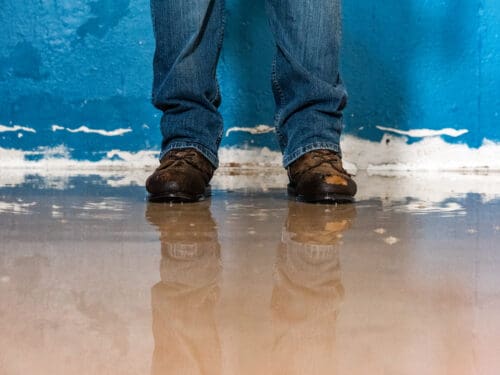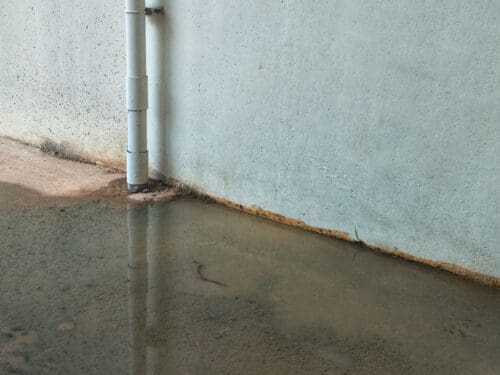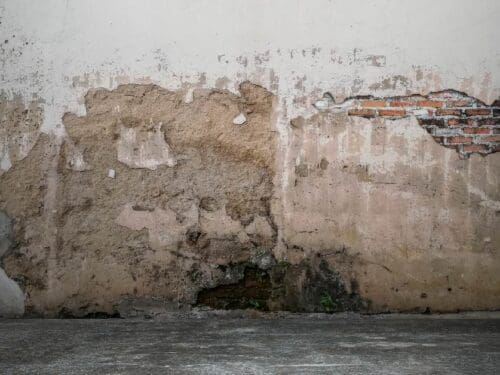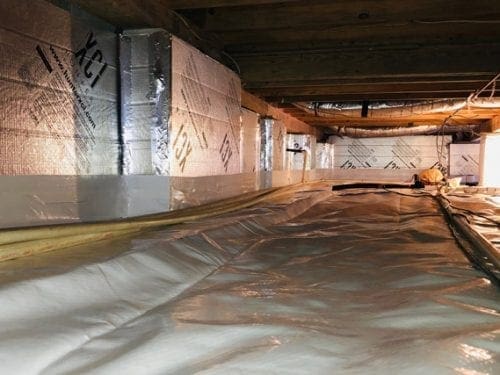Ever walk down into your basement and something just feels off?
Maybe the air smells damp. The walls are a little darker near the floor. There’s a spot in the corner that looks like it’s been wet… but you’re not sure if it’s new or just always been that way.
Most homeowners have that moment where you pause and think, “Is this something I need to worry about?”
Here’s the deal: water problems in basements usually don’t show up with a splash. They sneak in. Quietly. Slowly. Until one day it’s not just a damp spot, it’s ruined drywall, mold in the air, and foundation cracks that cost thousands to repair.
The worst part? By the time you see water, it’s often been leaking in for a while.
This post breaks down exactly how basement leaks happen, what causes them, the signs to look for, and ways for basement water leak repair.
If you’ve ever thought, “Is that water supposed to be there?” — keep reading.
Why Is Water Leaking Into Your Basement?
Your basement is underground. That means it’s constantly surrounded by soil — and when that soil gets saturated with water, it starts to push against your foundation walls. This is called hydrostatic pressure, and it’s one of the main reasons water forces its way inside.
Here are the top causes of basement water leaks:
- Poor drainage: Clogged gutters or short downspouts dump water too close to the house.
- Cracks in the foundation: Even hairline cracks can become leak points.
- Wall-floor joint leaks: Water often enters where the wall meets the floor — one of the weakest spots in your foundation.
- Improper grading: The ground should slope away from your house, not toward it.
- Lack of waterproofing: Older homes often lack proper sealing or drainage systems.
When any of these factors are at play, you’re left with water in places it shouldn’t be and the longer it sits, the more it damages.
How to Identify a Basement Water Leak (Before It’s Too Late)
Many homeowners miss the early signs. If you can catch them early, basement water leak repair becomes easier — and cheaper.
Watch for:
- Damp basement walls after a rainstorm
- Water stains on the floor or corners
- Peeling paint or bubbling drywall
- White powder (efflorescence) on the walls — a sign of past leaks
- Musty smell or visible mold
- Cracks in the concrete, especially near the corners or where walls meet floors
Basement leaks where wall meets floor are one of the most common and most overlooked signs that you need repair. That joint is under constant stress and can become a major water entry point.
Basement Water Leak Repair: Essential DIY Tips You Can Do Today
Some problems can be identified and improved with smart DIY fixes that stop water at the source, improve drainage, and give your foundation a break — especially if the issue is minor or just starting.
These tips won’t fix deep foundation cracks or severe water intrusion but they can make a big difference in controlling moisture and preventing damage from getting worse.
1. Extend Your Downspouts — It’s Cheap and It Works
This one’s almost too simple to believe — but it solves more problems than you’d think.
Most homes have downspouts that end just a foot or two from the foundation. That means every time it rains, water is dumping right next to your basement wall.
What to do:
- Buy a flexible or rigid downspout extension from any hardware store.
- Make sure it pushes water at least 6 to 10 feet away from your home.
- Angle it downhill if possible.
This single move can dramatically reduce how much water reaches your foundation.
2. Regrade the Soil Around Your Home
Over time, soil settles and slopes toward the house — exactly what you don’t want. Water follows gravity, and a bad slope means it heads straight for your basement.
DIY fix:
- Add fresh topsoil or fill dirt around your home’s perimeter.
- Build a gentle slope that drops 6 inches over the first 10 feet away from your house.
- Use a rake and compact the soil to keep it from settling quickly.
Avoid mulch or loose decorative stone near the foundation — they trap moisture.
3. Clean and Maintain Gutters Regularly
Clogged gutters overflow during rain and dump gallons of water down your siding and into your foundation. It’s one of the top causes of water in basements — and one of the easiest to fix.
What to do:
- Clean gutters twice a year (spring and fall).
- Check for clogs near downspout connections.
- Make sure the gutters aren’t sagging or pulling away from the house.
- Seal any leaks in the gutter seams with silicone caulk.
Bonus tip: Install gutter guards to cut down on future clean-up.
4. Use Hydraulic Cement for Small Cracks
If you notice hairline cracks in your basement wall — and water is seeping through during rain — you can use hydraulic cement to patch them.
How to use it:
- Clean the crack thoroughly with a wire brush.
- Mix the cement quickly (it sets fast).
- Press it into the crack with a putty knife and smooth it out.
- Let it cure fully before painting or finishing.
This is only for non-structural cracks. If cracks are wide, horizontal, or spreading, skip the DIY and call in a professional.
5. Apply Concrete Sealer to Damp Walls
If your basement walls feel damp but aren’t actively leaking, it may be due to moisture slowly seeping through the concrete.
What to do:
- Buy a silicate-based concrete sealer — these soak into the concrete and reduce moisture.
- Apply with a brush or roller to clean, dry walls.
- Follow the instructions for how many coats and drying time.
These sealers don’t stop active leaks, but they’re great for reducing dampness and musty smells.
6. Add a Dehumidifier to Control Basement Humidity
Sometimes, it’s not a leak — it’s humidity buildup causing condensation, musty smells, and mold.
DIY solution:
- Buy a 50–70 pint dehumidifier (depending on basement size).
- Set it to 45–50% humidity.
- Run it continuously during humid months.
- Empty it regularly or connect it to a floor drain.
This won’t fix leaks but helps prevent secondary damage like mold or rot.
7. Install Window Well Covers
If your basement windows are at or below ground level, rain and snow can collect in the wells — and leak into the basement.
How to prevent it:
- Clean out any debris from the window wells.
- Install clear polycarbonate window well covers (you can find these at most hardware stores).
- Make sure they’re sealed well enough to keep rain out but still allow light in.
This helps prevent a common entry point for water, especially in older homes.
8. Seal Around Pipes That Enter the Foundation
Sometimes water sneaks in where utility lines (gas, water, electrical) pass through the foundation wall. These spots are often overlooked — and poorly sealed.
DIY fix:
- Use a can of spray foam insulation or urethane caulk.
- Fill any visible gaps around pipes or conduits where water could seep in.
- If the gap is large, stuff in backer rod foam before sealing it.
Small move, big payoff especially during storms.
These DIY tips won’t solve major foundation issues or flooding, but they can stop small leaks from turning into big ones and often prevent water from reaching your basement in the first place.
Fix what you can. Know what you can’t. And don’t wait until your basement becomes a swimming pool. If you’ve tried some or all of these and water is still showing up, it’s time for professional help.
Not All Basement Leaks Are the Same: Here’s What They Mean
You may just see water, but a pro sees what that water is telling you.
Let’s break down the common leak types and what they might mean for your foundation:
Leaking Basement Wall
Water stains running down the wall usually mean there’s either a crack or moisture is seeping through porous concrete. This is often caused by poor drainage outside.
Basement Cracks and Leaks
Vertical cracks can form due to settling. Horizontal cracks are more serious and may mean that soil pressure is pushing the wall inward. If ignored, these can lead to structural failure.
Leaks at Wall-Floor Joint
This is where the floor slab meets the wall — it’s often the path of least resistance. Water can seep up from beneath or come through this joint after heavy rains.
Understanding the type of leak helps determine the right solution — not all leaks are fixed the same way.
DIY Fixes vs. Professional Basement Water Leak Repair
It’s tempting to try to fix a water leaking in the basement yourself — especially if it seems small.
And yes, there are a few things you can do on your own:
| DIY Fix | What It Helps With |
| Extending downspouts | Keeps water away from the foundation |
| Regrading soil | Improves drainage away from your home |
| Sealing hairline cracks | Temporary fix for very minor leaks |
| Running a dehumidifier | Helps reduce moisture and odor |
But here’s the truth: DIY only works on the surface. It won’t stop ongoing foundation damage, and it won’t solve deeper structural problems.
If water is entering during or after storms, or you see repeated leaks, it’s time to bring in a pro for basement foundation leak repair.
When to Seek Professional Help
If your basement still feels damp no matter what you try or you’re dealing with standing water, wet basement walls, or signs of efflorescence, it’s time to bring in an expert.
Failed DIY fixes, persistent moisture, or foundation cracks(especially large ones) are all red flags that point to deeper issues.
A professional basement inspection can identify problems like missing vapor barriers, damaged basement waterproofing components, or even the need for structural reinforcement.
Don’t wait for the damage to spread — some problems can’t be sealed with a tube of caulk and good intentions.
The Best Long-Term Fixes for a Leaky Basement
When it comes to permanently solving basement water problems, professionals focus on root causes, not just symptoms.
Here are the most effective leaky basement repair methods:
Interior Drainage Systems
These are installed under the basement floor. Water is redirected into a sump pump system that pushes it away from your home. Ideal for managing ongoing leaks.
Exterior Waterproofing
A membrane is applied to the outside of your foundation, along with a drain tile system. It’s invasive but highly effective — it blocks water before it ever reaches the basement.
Crawlspace Encapsulation
If your home has a crawlspace, moisture there can travel to the basement. Encapsulation seals it off with vapor barriers and insulation, reducing humidity and preventing leaks.
Each of these solutions targets a specific type of water leaking in the basement. The best results often come from combining methods based on your home’s needs.
Want to learn more ways to keep your basement dry year-round? Read this guide for ongoing prevention strategies.
What Happens If You Don’t Fix a Basement Leak?
The real cost of ignoring water damage isn’t just money — it’s stress, health risks, and long-term damage to your home.

That’s why basement water leak repair isn’t optional — it’s essential. Whether you’re staying in your home or planning to sell, water problems will come back to bite you if left alone.
How Much Does Basement Leak Repair Cost?
Let’s be honest — basement repairs can range from simple fixes to full-scale waterproofing systems, depending on how bad the damage is and what’s causing it.
Some situations only need a minor crack sealed or a sump pump added. Others require a full interior drainage system, exterior waterproofing, or both — especially if water’s been leaking in for a while or there’s visible damage to the foundation.
The important thing to remember is this: It always costs less to fix the problem early.
Waiting turns a manageable repair into a much bigger, more expensive one. And that doesn’t even include what water damage can do to your furniture, flooring, stored items, or air quality.
So if you’re on the fence, think long term: fixing the problem now protects your investment and gives you peace of mind, especially during the next big storm.
And with a professional inspection, you’ll know exactly what you need (and nothing you don’t).
Ready to Fix That Leak for Good?
A leak is never just a leak.
It’s a warning sign. A cry for help from the part of your home that holds everything up — your foundation.
Sure, it starts with a trickle. A damp spot. Maybe a tiny crack you hardly notice. But given time? That trickle can flood. That crack can grow. That musty smell can become mold creeping into your air.
But, you can stop it. You can take control before water controls your home — and your wallet.
At Virginia Foundation Solutions, we’ve seen it all:
- The homes with leaky basement walls that turned into collapsed foundations
- The families overwhelmed with mold damage
- The “minor” cracks that ended up costing tens of thousands
We don’t want that to be your story. We want to be the call that saved your basement and your home.
With our expert team, proven methods, and commitment to quality, we don’t just fix problems — we prevent them. We inspect. We explain. We repair. We protect.
Contact us now for a free inspection. We serve the Virginia Beach area with professionalism, experience, and care. Because at the end of the day… Your Home is Our Mission.
Frequently Asked Questions About Basement Leak Repair
What should I do if my basement smells musty?
A musty basement smell is often a sign of moisture or mold. That odor doesn’t come out of nowhere — it means water is entering your basement or humidity levels are too high. Start by checking for visible water, damp spots, or condensation. A moisture inspection can help pinpoint the cause, whether it’s a hidden leak or poor ventilation.
How do I know if I need professional basement waterproofing?
If you’re dealing with recurring dampness, water after heavy rains, or visible cracks, it’s time to bring in a professional. A licensed waterproofing expert can assess the damage, explain your options, and provide a clear basement waterproofing estimate. DIY can work for minor fixes — but not for long-term protection.
Are liquid rubber sealants effective?
Liquid rubber sealants are often used as part of a waterproofing system, especially on exterior walls. They create a flexible barrier that prevents water from seeping through concrete or block walls. When applied professionally, they can be effective — but they’re just one part of a full repair plan.
What’s better: waterproofing paint or concrete sealers?
Waterproofing paints are usually cosmetic — they help reduce surface dampness but don’t solve deeper leaks. Silicate-based concrete sealers, on the other hand, penetrate the concrete and help reduce porosity. They’re better for long-term moisture control but are still limited if water is coming in through cracks or floor joints.
Can I seal basement cracks myself?
Yes — small hairline cracks can sometimes be sealed with DIY products. But if water is actively coming through, or if the crack is widening, you need professional repair. Some cracks signal foundation movement, and surface sealing won’t fix the real problem underneath.
How do I eliminate odors caused by basement moisture?
To truly get rid of the musty basement smell, you need to remove the source of moisture — not just cover it up. This means fixing leaks, improving drainage, sealing cracks, and sometimes adding a dehumidifier. For odor elimination to last, the space needs to stay dry and mold-free.
What are the most effective basement leak repair methods?
There’s no one-size-fits-all answer. The best repair methods depend on your basement’s design, what kind of leak you have, and how much water is coming in. Common solutions include:
- Interior drainage systems with sump pumps
- Wall crack injections
- Crawl space encapsulation
- Exterior waterproofing with membranes and drain tile
- Vapor barriers and concrete sealers
A professional will recommend the right combo based on your exact situation.
